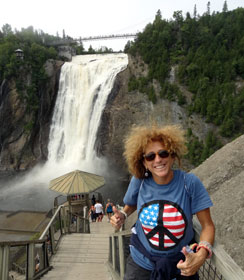The Clean Water Network Celebrates Clean Water Act 40th Anniversary
This is a guest blog from Natalie Roy, Executive Director, Clean Water Network that was presented on the American Rivers website.
When I was ten years old, I wrote letters to President Lyndon Johnson and New York Mayor John Lindsey.
The letters conveyed my ten-year-old sense of outrage about polluted air and water as well as dismay about litter on the streets. My friends and I even made up a song about pollution on our way to an outdoor field trip.
My teacher that year had us make a film (no videos back then) about taking care of our natural resources. I played the role of kid who abused the environment. The year was 1968.
It is an understatement to say there was plenty of turmoil that year. Protests, riots, and assassinations were in the fabric of the time, but so were advances in civil rights and women’s rights. We were about solving problems then. Everyone wanted to change the world and make a difference. Activism was not only a good thing, but something cool.
Activism was also the only way to save the planet. This was the time of burning rivers, raw sewage spewing into waterways, and dead lakes. Everyone seemed to recognize that something had to change or we were going to destroy ourselves and our planet. Whatever side of the political isle people were on, they were, at least in my ten year old mind, all on the same environmental team. Clean Air and Water were essential to life, end of discussion.
During this heightened period of environmental consciousness, the Clean Water Act was enacted, forty years ago this October 18th. Even though President Nixon vetoed the Act, Congress overrode the veto by a margin of more than 10-1. It seemed unfathomable that anyone could not see how fighting to protect our precious water resources was not in everyone’s best interest.
Since the passage of the Clean Water Act (CWA) in 1972, many of our waterways have become less polluted. Lake Erie, for example, which was declared “dead” in the 1960’s, now supports a multi-million dollar fishery. Pollution in river systems like the Mississippi from “point sources” such as sewage treatment plants and industrial facilities, has been dramatically reduced. In 1970, point-source contaminants from industrial facilities accounted for 85% of the pollutants in our waters, and today account for only 15%. The rate of wetland loss has declined by 90% since the 1970’s.
We are indebted to the visionaries responsible for crafting the Clean Water Act, landmark legislation that protects our nation’s precious water resources. But many challenges remain. Forty years later, nearly half of all rivers, lakes and streams are still not swimmable and fishable. Funding levels and federal regulatory safeguards have not kept pace with our evolving water pollution and infrastructure problems. Worse, exemptions in current law allow the natural gas industry, agribusiness and other industries to pollute our water supplies. While today burning rivers are a thing of the past, we have a wide range of serious pollution challenges on our radar screen for the 21st century.
These challenges include detectable amounts of pharmaceuticals in drinking water, legacy mining waste polluting our waterways, hundreds of new chemicals being introduced into the marketplace every year, a nearly threefold increase in nitrogen pollution entering the Gulf of Mexico from the Mississippi River and its tributaries, a natural gas drilling boom threatening drinking water supplies, new crops of emerging contaminants, invasive species threats, and pollution from agricultural and stormwater runoff.
Clean water is also under attack by many Members of Congress – agencies are being defunded and numerous pieces of legislation and policy riders have been introduced to limit the scope and enforcement teeth of the Clean Water Act. Sadly, environmental activism is no longer considered cool. We do not all seem to be on the same team. There are endless attacks by polluters to roll back federal authority to protect water quality in rivers, streams, lakes, bays, wetlands and coastal areas nationwide.
We are at a clean water crossroads. Really it is an environmental crossroads. We need to re-engage fellow citizens about the threats to our freshwater resources, both in our own communities and nationally. Public opinion polls consistently show that Americans care about clean water and worry about pollution in rivers, streams and lakes. Americans do not want to go back to the days when states had inconsistent water quality protections, when they discharged untreated sewage and other pollutants into waterways, creating environmental and health problems for their downstream neighbors.
This year, during the 40th anniversary of the Clean Water Act, it is important to not only celebrate this milestone, but redouble our clean water advocacy efforts going forward. It is time to rekindle that environmental activism energy! More than forty years ago the country’s water pollution problems were easy for a ten year old to spot. It was easy to see the pollution back then. Today the problems are more complex and difficult to detect for a ten year old or for anyone for that matter. The Clean Water Act anniversary is a great time for all of us to reflect on past successes as well as scope out the serious clean water challenges of the 21st century.
Our challenge is simple. Leave this planet in better shape than when we found it so we are not leaving problems for the ten year old kids of today. Join the Clean Water Network as we celebrate the 40th Anniversary and look forward, this Thursday on Capitol Hill – details here.
– See more at: http://www.americanrivers.org/blog/the-clean-water-network-celebrates-clean-water-act-40th-anniversary/#sthash.6mQaaWZ6.dpuf

